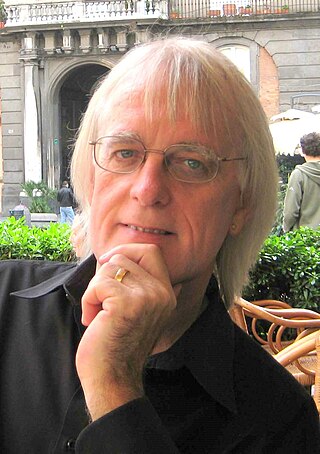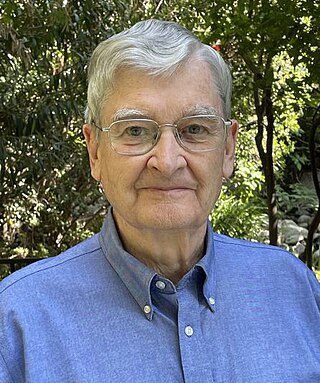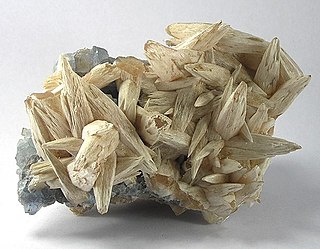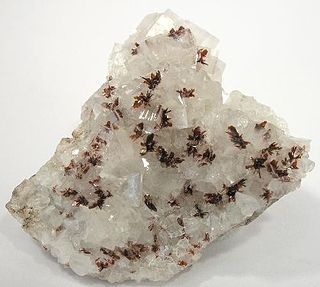Related Research Articles

Abernathyite is a mineral with formula K(UO2)(AsO4)·3H2O. The mineral is named after Jesse Evrett Abernathy (1913–1963) who first noted it in 1953 in the U.S. State of Utah. It was described as a new mineral species in 1956. Abernathyite is yellow and occurs as small crystals.

Frank Christopher Hawthorne is an English-born Canadian mineralogist, crystallographer and spectroscopist. He works at the University of Manitoba and is currently distinguished professor emeritus. By combining graph theory, bond-valence theory and the moments approach to the electronic energy density of solids he has developed bond topology as a rigorous approach to understanding the atomic arrangements, chemical compositions and paragenesis of complex oxide and oxysalt minerals.

Nickel–Strunz classification is a scheme for categorizing minerals based upon their chemical composition, introduced by German mineralogist Karl Hugo Strunz in his Mineralogische Tabellen (1941). The 4th and the 5th edition was also edited by Christel Tennyson (1966). It was followed by A.S. Povarennykh with a modified classification.

George R. Rossman is an American mineralogist and the Professor of Mineralogy at the California Institute of Technology.
Elements: An International Magazine of Mineralogy, Geochemistry, and Petrology is a bimonthly peer-reviewed scientific journal published by 18 scientific societies: Mineralogical Society of America, Mineralogical Society of Great Britain and Ireland, Mineralogical Association of Canada, Clay Minerals Society, Geochemical Society, European Association of Geochemistry, International Association of GeoChemistry, Société Française de Minéralogie et de Cristallographie, Association of Applied Geochemists, Deutsche Mineralogische Gesellschaft, Società Italiana di Mineralogia e Petrologia, International Association of Geoanalysts, Polskie Towarzystwo Mineralogiczne, Sociedad Española de Mineralogía, Swiss Society of Mineralogy and Petrology, Meteoritical Society, Japan Association of Mineralogical Sciences and the International Association on the Genesis of Ore Deposits. It was established in January 2005.
Bernard (Bernie) Wood is a British geologist, and professor of mineralogy and senior research fellow at the University of Oxford. He specializes in the thermodynamics of geological systems, using experimental techniques. He is a prominent figure in the field of experimental petrology, having received multiple awards throughout his career and taught at several universities worldwide.
Ivan Kostov Nikolov Hon HonFMinSoc, Aka Ivan Kostov, was a Bulgarian geologist, mineralogist and crystallographer.
In mineralogy, the type specimen, also known as type material, is a reference sample by which a mineral is defined. Similar to the biology type methods, a mineral type specimen is a sample of a mineral to which the scientific name of that mineral is formally attached. In other words, a type specimen is an example that serves to anchor or centralize the defining features of that particular mineral.

Benstonite is a mineral with formula Ba6Ca6Mg(CO3)13. Discovered in 1954, the mineral was described in 1961 and named after Orlando J. Benston (1901–1966).

Ruizite is a sorosilicate mineral with formula Ca2Mn2Si4O11(OH)4·2H2O. It was discovered at the Christmas mine in Christmas, Arizona, and described in 1977. The mineral is named for discoverer Joe Ana Ruiz.

Junitoite is a mineral with formula CaZn2Si2O7·H2O. It was discovered at the Christmas mine in Christmas, Arizona, and described in 1976. The mineral is named for mineral chemist Jun Ito (1926–1978).
Georgius Agricola is considered the 'father of mineralogy'. Nicolas Steno founded the stratigraphy, the geology characterizes the rocks in each layer and the mineralogy characterizes the minerals in each rock. The chemical elements were discovered in identified minerals and with the help of the identified elements the mineral crystal structure could be described. One milestone was the discovery of the geometrical law of crystallization by René Just Haüy, a further development of the work by Nicolas Steno and Jean-Baptiste L. Romé de l'Isle. Important contributions came from some Saxon "Bergraths"/ Freiberg Mining Academy: Johann F. Henckel, Abraham Gottlob Werner and his students. Other milestones were the notion that metals are elements too and the periodic table of the elements by Dmitri Ivanovich Mendeleev. The overview of the organic bonds by Kekulé was necessary to understand the silicates, first refinements described by Bragg and Machatschki; and it was only possibly to understand a crystal structure with Dalton's atomic theory, the notion of atomic orbital and Goldschmidt's explanations. Specific gravity, streak and X-ray powder diffraction are quite specific for a Nickel-Strunz identifier. Nowadays, non-destructive electron microprobe analysis is used to get the empirical formula of a mineral. Finally, the International Zeolite Association (IZA) took care of the zeolite frameworks.
Joseph (Joe) Anthony Mandarino OC, FRSC was an American-Canadian mineralogist and crystallographer.

Janne Blichert-Toft is a geochemist, specializing in the use of isotopes with applications in understanding planetary mantle-crust evolution, as well as the chemical composition of matter in the universe. To further this research, Blichert-Toft has developed techniques for high-precision Isotope-ratio mass spectrometry measurements.

Michael Fleischer was an American chemist and mineralogist. He worked as a geochemist with the U.S. Geological Survey from 1939 to 1978. He published a huge number of chemical abstracts and reviews of proposed mineral names, and is known for his authoritative Glossary of Mineral Species, first published in 1971.
J. Frank Schairer was an American geochemist, mineralogist, and petrologist.
Roymillerite is a solid colorless transparent crystalline mineral. It has a non-trivial crystal structure.
Stepan Tigranovich Badalov was a Soviet and Uzbek mineralogist and geochemist, Doctor of Geological and Mineralogical Sciences (1962) and Professor (1968). He was a Meritorious Scientist of the Republic of Uzbekistan and an Honorary Member of the Russian Mineralogical Society. He is considered the founder of isotope geochemistry.
References
- ↑ Past IMA Councils
- ↑ CNMNC - Commission members
- ↑ de Fourestier, Jeffrey (2002). "The Naming of Mineral Species Approved by the Commission on New Minerals and Mineral Names of the International Mineralogical Association: A Brief History". The Canadian Mineralogist. 40 (6): 1721–1735. Bibcode:2002CaMin..40.1721D. CiteSeerX 10.1.1.579.3170 . doi:10.2113/gscanmin.40.6.1721.
- ↑ Sociedad Española de Mineralogía: History Retrieved 2011-05-31